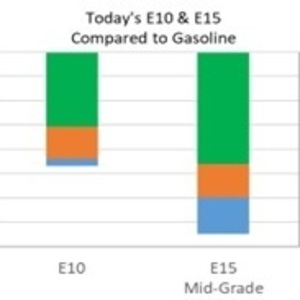Getting the most carbon credit for ethanol

March 22, 2023
BY Dave Vander Griend, ICM Inc.
Today, modeling ethanol’s carbon reduction focuses on CO2 emitted per unit of energy, primarily from farming, ethanol production and distribution. The U.S. Department of Energy’s GREET model shows ethanol has 44 percent lower carbon emissions compared to gasoline.
Modeling ethanol’s carbon emissions derived from corn is often referred to as “Field to Wheels,” but this does not capture the benefits of what changes in the finished fuel (chemistry) or improved vehicle effeciency. These two areas also improve the CO2 reduction benefits that ethanol has to offer.
When the U.S. gasoline market moved mostly to E10 fuels starting in 2006, the oil refineries not only lowered the octane of the gasoline portion of E10, they also lowered the aromatic hydrocarbon content by roughly 25 percent. Meaning the E10 gasoline market for the past decade, has been displacing roughly eight billion gallons of toxic aromatics annually.
Advertisement
Aromatics produces far greater amounts of CO2 emisisons per unit of energy (Btu) then any other component of gasoline. This may seem small to some,but this reduction of CO2 due to the changes in the fuel make-up, reduces CO2 emissions by roughly 12 to 14 million tons annually. This is slightly higher than the projected reduction of CO2 from the proposed CO2 pipeline across Iowa.
The second area of CO2 reduction not included in carbon modeling is the benefit of octane and higher engine efficiency. Today, most modern vehicles will take advantage of some increase of octane. Currently, E15 offers Mid-Grade octane performance since 5 percent more ethanol is being added to regular E10. This simple addition of ethanol to gasoline ensures a reduction in both tailpipe and evaporative emissions along with lowering carbon emisisons due to higher engine efficiency. On average, there should be no mpg loss with E15 for modern vehicles as long as ethanol is simply added to current E10 gasoline.
Advertisement
The green bars in this figure charts current average CO2 reduction for entire production of corn ethanol per the DOE GREET model. The orange bars reflect the change in the gasoline with the greatest reduction occurring with E10 due to aromatic displacement. The blue bars represent the CO2 reduction due to higher engine efficiency.
The interesting thing about this figure is that the E10 benefits are already validated by EPA testing in this Tier 3 Fuels Impact Study. E10 had a 0.3 percent efficiency gain over E0 gasoline and the E10 fuel had 1.3 percent less carbon per unit of energy due to lower aromatic content. EPA’s own data shows a 1.6 percent CO2 reduction mostly due to E10’s lower aromatic content. Unfortunately, instead of EPA crediting ethanol with this CO2 reduction, EPA penalized the auto industry 1.6 percent by saying EPA needed to maintain the same CO2 emissions rate per unit of energy as an old E0 gasoline reference fuel dating back over 40 years.
Simply allowing the addition of ethanol to current E10 gasoline is a win for the environment and consumers.
Related Stories
CountryMark on July 22 celebrated the completion of more than $100 million in upgrades at its refinery in Indiana, including those related to soybean oil storage. The facility produces renewable diesel via coprocessing technology.
ATOBA Energy and Air Moana are partnering to implement scalable solutions for the supply of SAF. The collaboration aims to ensure long-term SAF availability while supporting local initiatives to develop sustainable fuel production in Tahiti.
While final IRS guidance is still pending, the foundation of the 45Z program is well defined. Clean fuel producers should no longer be waiting; they can now move forward with critical planning and preparation, according to EcoEngineers.
Neste Corp. on July 24 released second quarter results, reporting record quarterly renewable product sales volumes despite weaker margins. SAF sales were up nearly 80% when compared to the first quarter of 2025.
Valero Energy Corp. on July 24 released second quarter results, reporting a profitable three-month period for its ethanol segment. The renewable diesel segment posted a loss, but the company’s new sustainable aviation fuel (SAF) unit operated well.
Upcoming Events










